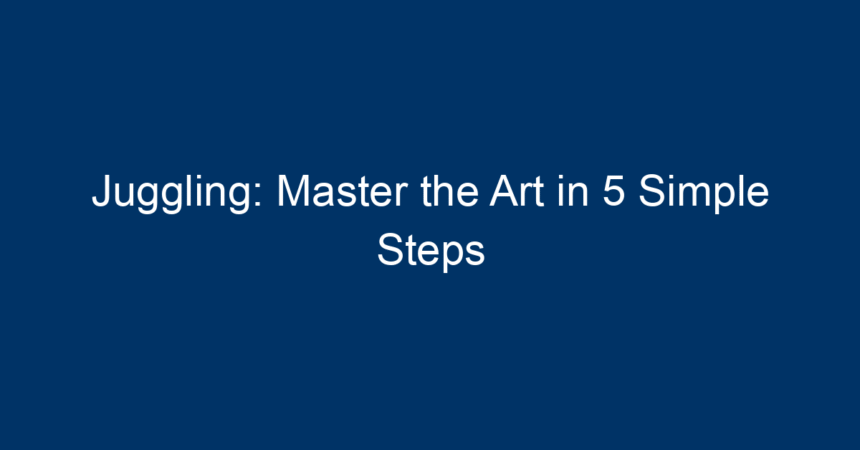Juggling is not just a party trick; it’s an ancient art form that combines coordination, concentration, and creativity. Whether you’re searching for a fun way to impress friends, develop new skills, or enhance your cognitive abilities, learning to juggle can be both rewarding and entertaining. In this article, we’ll explore five simple steps to master the art of juggling, guiding you through the basics and offering tips for progression.
Why Juggling?
Before diving into the steps, let’s discuss why juggling is a valuable skill to learn.
Benefits of Juggling
-
Cognitive Growth: Juggling has been shown to improve brain function, enhancing memory, focus, and problem-solving skills.
-
Hand-Eye Coordination: As a physical activity, juggling sharpens your reflexes and motor skills.
-
Stress Relief: Engaging in juggling can serve as a form of meditation, helping to reduce stress while promoting mindfulness.
- Social Skills: Mastering juggling provides an opportunity to connect with others, share techniques, and even perform.
By understanding these benefits, you’ll be motivated to tackle juggling with enthusiasm!
Step 1: Start with One Ball
Understanding the Basics
Before you attempt to juggle multiple objects, it’s crucial to master the fundamentals with one ball. Here’s how to do it:
-
Choose Your Ball: Pick a soft ball that’s easy to grip, such as a beanbag or a rubber ball.
-
Start from the Standstill: Stand with your feet shoulder-width apart, holding the ball in one hand.
-
The Throw: Throw the ball straight up in the air, aiming for a height of about eye level. As a beginner, the throw should feel comfortable; focus on smoothness rather than height.
-
Catch it: Extend your opposite hand above the first, ready to catch the ball as it comes down. Repeat this for several minutes to get comfortable with the rhythm.
- Practice, Practice, Practice: The key here is repetition. Spend time perfecting the throw and catch before moving on to more balls.
Progress Tracker
Keep a journal of your practice sessions. Note your progress, and don’t be discouraged by initial difficulties; juggling takes time to master!
Step 2: Introducing a Second Ball
Adding Complexity
Once you’re comfortable with one ball, it’s time to introduce a second. Here’s how to proceed:
-
Hand Changes: Hold one ball in each hand. Start by throwing the ball from your dominant hand, just as you did with the first ball.
-
Cross and Catch: As the first ball reaches its peak, throw the second ball from your non-dominant hand.
-
Catch and Repeat: Focus on catching the first ball with your non-dominant hand before catching the second ball with your dominant hand.
- Rhythm is Key: The secret to juggling is rhythm. Try to keep a consistent beat as you throw.
Focusing on Timing
Use a metronome or simply count in your head to develop a rhythm. Consistent throws and catches will help enhance your coordination.
Step 3: The Three-Ball Cascade
The Classic Juggling Pattern
The classic three-ball cascade is the most recognized juggling pattern. Here’s how to make it happen:
-
Hands Ready: Start with two balls in your dominant hand and one in the other.
-
The First Throw: Begin by throwing the first ball from your dominant hand, just as you practiced with one ball.
-
Timing the Throws: When the first ball reaches the peak, throw the ball from your non-dominant hand. As the second ball peaks, throw the second ball from your dominant hand.
- Catch: Aim to catch the first ball with your non-dominant hand, and then catch the second ball in your dominant hand.
Consistency is Key
Focus on making each throw consistent. It’s common to feel overwhelmed at first, but practice will lead to improvement.
Step 4: Troubleshooting Common Mistakes
Identifying Issues
Learning to juggle can come with its share of frustrations. If you’re struggling, consider these common mistakes:
-
Inconsistent Throws: Ensure your throws are smooth and consistent. Aim for a consistent height and angle.
-
Too Much Force: Beginners often throw too hard. Focus on control rather than power.
- Loss of Rhythm: If you find yourself losing a beat, slow down your throws to regain your rhythm and timing.
Practical Solutions
-
Video Yourself: Recording your practice can provide insights into your technique and highlight areas that need improvement.
- Ask for Help: Find a juggling partner or community to share tips and encouragement.
Step 5: Advanced Techniques
Going Beyond Basics
Once you’ve mastered the three-ball cascade, you can expand your repertoire. Here are some advanced techniques:
-
Changing Patterns: Experiment with different patterns, such as the four-ball fountain or the half-shower.
-
Adding Props: Try juggling with different objects like clubs, rings, or even flaming torches (after mastering basic skills).
- Incorporating Tricks: Once you’re confident, practice tricks like under-the-leg throws, behind-the-back catches, or even juggling with a partner.
Keep Challenging Yourself
The beauty of juggling lies in its endless possibilities. Set new challenges for yourself regularly to continue improving and keep the practice enjoyable.
Conclusion: Your Juggling Journey Begins!
Juggling is a fulfilling skill that opens up a world of creativity and coordination. By following these five simple steps—starting with one ball, moving to two, tackling the three-ball cascade, troubleshooting common challenges, and then advancing to more complex techniques—you can master the art of juggling.
Actionable Insights
- Dedicate at least 10-15 minutes a day to practice.
- Celebrate small milestones to keep motivation high.
- Explore juggling communities for support and inspiration.
As you master juggling, remember that practice makes perfect. So, pick up those balls, and start your juggling journey today! Not only will you be honing a fantastic skill, but you’ll also enjoy the numerous mental and physical benefits that come along with it. Happy juggling!




